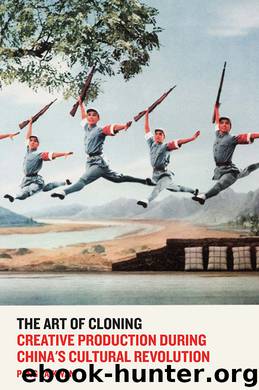The Art of Cloning by Pang Laikwan

Author:Pang Laikwan
Language: eng
Format: epub
Publisher: Verso Books
The Cultural Workers
This book aims to illustrate how social mimesis could be a multidimensional mechanism involving not only individual changes but also institutional transformations and cultural fissures. If I have characterized the medical institution, which featured the barefoot doctor as its embodiment, as a rather successful social reform project because it could be easily copied by local communities, we might consider opera transplantation a rather unsuccessful social mimesis project because unlike the original yangbanxi very few people actually sang the songs. However, while the masses did not sing the transplanted pieces, the opera singers did—and there were plenty of them. They were probably the most significant subjects of emulation in the case of opera transplantation because they personified the ideology.
After 1949, a vigorous institutionalization process was put in place in regional operas to offer the performers and musicians professional status. The Chinese Xiqu Institute was set up in 1951 to implement a new pedagogical and epistemological system for all major types of regional operas. Cultural workers’ unions were also established around the country, including the Guangzhou Cantonese Opera Workers Association, channeling messages from the party directly to the practitioners. We also saw the development of the director system, which was launched to guarantee some kind of general control, both aesthetically and politically, over all regional operas.53 Strategic units were established, such as the Experimental Troupes in Guangdong Province Cantonese Opera Company, to experiment with innovative works.54
But in terms of business structure, theatrical groups were never completely nationalized, and there were parallel structures of government-owned groups (guoying) and non-government-owned groups (minying).55 Private groups were always key players in the overall theatrical scene during the seventeen-year period, and they did not entirely disappear even during the Cultural Revolution. The most important policy intervention involved the salary system: in 1958, the government endorsed a pay scale of sixteen salary points for all performance groups, from 42 RMB to 360 RMB,56 which not only prevented too great an income disparity among the cultural workers but also effectively organized them into a system that could be controlled by the state. Under this system, key performers still received higher salaries, followed by musicians and stage workers; however, generally speaking, subsidiary performers, set designers, and other stage workers were given social status and salaries comparable to those of the stars.
To understand the newly conferred “professional” status to opera workers in the PRC, we can compare the Guangzhou situation with Hong Kong’s, as Cantonese Opera developed vigorously in both places in the 1950s and 1960s. To the revolutionary regime, an original sin of Cantonese Opera was its cultural affinity with colonial Hong Kong and Macau, as well as the Chinese diaspora. Some critics argue that Cantonese Opera was the regional opera most condemned by the socialist critical apparatus precisely due to its outside links.57 But it also had to be promoted due to its effectiveness as propaganda in overseas Chinese communities.58 In Hong Kong, Cantonese Opera’s active collaboration with cinema and popular culture at large followed and reinforced the opera’s audacity and valiance.
Download
This site does not store any files on its server. We only index and link to content provided by other sites. Please contact the content providers to delete copyright contents if any and email us, we'll remove relevant links or contents immediately.
| Arms Control | Diplomacy |
| Security | Trades & Tariffs |
| Treaties | African |
| Asian | Australian & Oceanian |
| Canadian | Caribbean & Latin American |
| European | Middle Eastern |
| Russian & Former Soviet Union |
The Secret History by Donna Tartt(18061)
The Social Justice Warrior Handbook by Lisa De Pasquale(11931)
Thirteen Reasons Why by Jay Asher(8401)
This Is How You Lose Her by Junot Diaz(6403)
Weapons of Math Destruction by Cathy O'Neil(5781)
Zero to One by Peter Thiel(5448)
Beartown by Fredrik Backman(5294)
The Myth of the Strong Leader by Archie Brown(5205)
The Fire Next Time by James Baldwin(4992)
How Democracies Die by Steven Levitsky & Daniel Ziblatt(4934)
Promise Me, Dad by Joe Biden(4891)
Stone's Rules by Roger Stone(4821)
100 Deadly Skills by Clint Emerson(4649)
Rise and Kill First by Ronen Bergman(4529)
A Higher Loyalty: Truth, Lies, and Leadership by James Comey(4523)
The David Icke Guide to the Global Conspiracy (and how to end it) by David Icke(4349)
Secrecy World by Jake Bernstein(4345)
The Farm by Tom Rob Smith(4295)
The Doomsday Machine by Daniel Ellsberg(4224)
